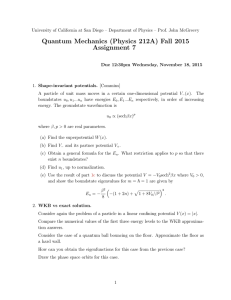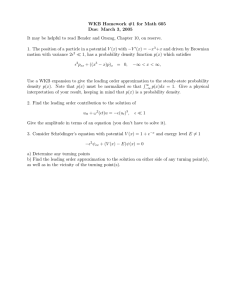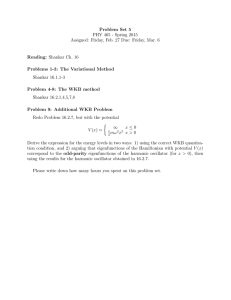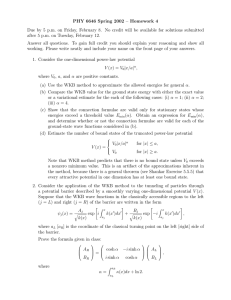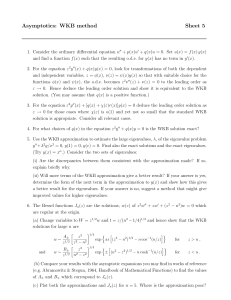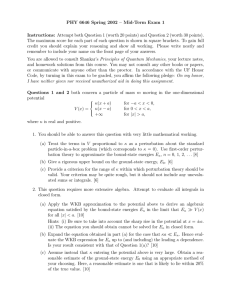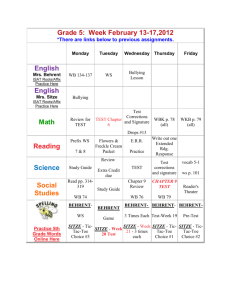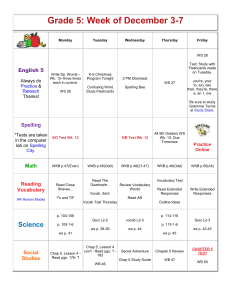Perturbation Theory and the WKB Method
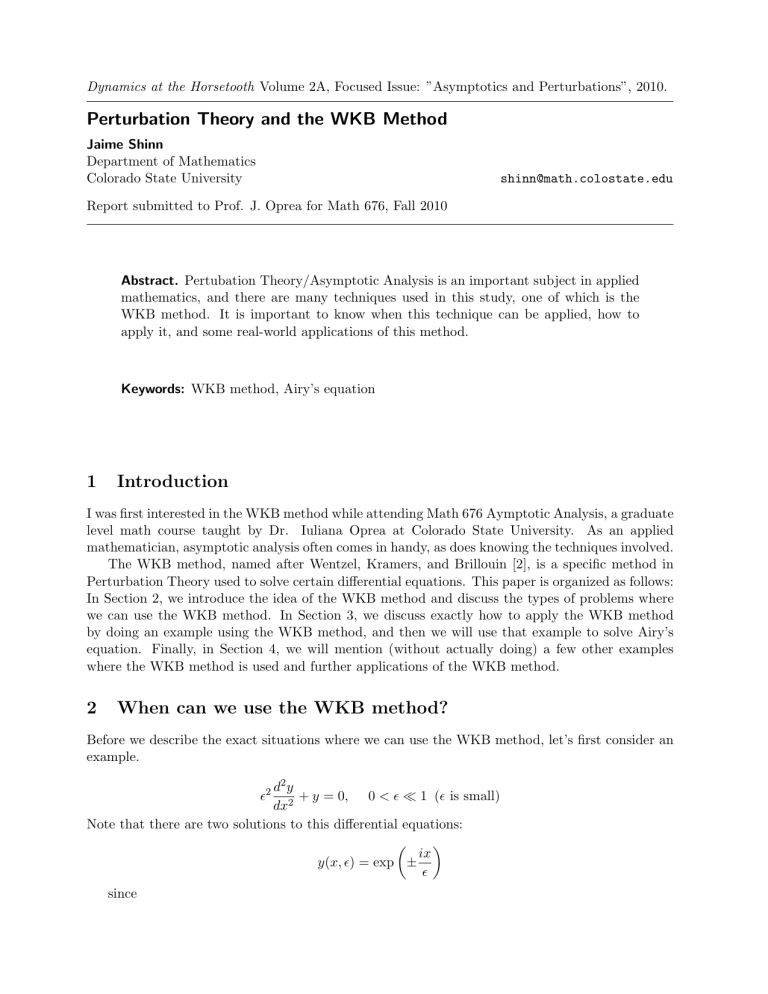
Dynamics at the Horsetooth Volume 2A, Focused Issue: ”Asymptotics and Perturbations”, 2010.
Perturbation Theory and the WKB Method
Jaime Shinn
Department of Mathematics
Colorado State University
Report submitted to Prof. J. Oprea for Math 676, Fall 2010 shinn@math.colostate.edu
Abstract.
Pertubation Theory/Asymptotic Analysis is an important subject in applied mathematics, and there are many techniques used in this study, one of which is the
WKB method. It is important to know when this technique can be applied, how to apply it, and some real-world applications of this method.
Keywords: WKB method, Airy’s equation
1 Introduction
I was first interested in the WKB method while attending Math 676 Aymptotic Analysis, a graduate level math course taught by Dr.
Iuliana Oprea at Colorado State University.
As an applied mathematician, asymptotic analysis often comes in handy, as does knowing the techniques involved.
The WKB method, named after Wentzel, Kramers, and Brillouin [2], is a specific method in
Perturbation Theory used to solve certain differential equations. This paper is organized as follows:
In Section 2, we introduce the idea of the WKB method and discuss the types of problems where we can use the WKB method. In Section 3, we discuss exactly how to apply the WKB method by doing an example using the WKB method, and then we will use that example to solve Airy’s equation. Finally, in Section 4, we will mention (without actually doing) a few other examples where the WKB method is used and further applications of the WKB method.
2 When can we use the WKB method?
Before we describe the exact situations where we can use the WKB method, let’s first consider an example.
2 d
2 y dx 2
+ y = 0 , 0 < 1 ( is small)
Note that there are two solutions to this differential equations: y ( x, ) = exp ± ix since
Perturbation Theory and the WKB Method Jaime Shinn dy dx
= ± i exp ± ix and d
2 y dx 2
= i
2
2 exp ± ix
=
− 1 exp ± ix
2
.
It is important to notice that this solution oscillates rapidly on a scale of O ( ). These are the types of problems that are ideal for the WKB method because we want to be able to assume that the solution is in a specific form. We will discuss this idea further when we discuss the ansatz in
Section 2. In general, we can use the WKB method to solve problems in the following form:
2 d
2 y dx 2
+ F ( x ) y = 0 , 0 < 1 , where F ( x ) is smooth and positive on the O (1) scale [1] .
Again, we can use the WKB method here because the solution(s) will have rapid oscillations on a scale of O ( ) with an amplitude and phase which both vary on a scale of O (1) (they both vary slowly) [1]. We can only use the WKB method in these situations because the it requires an ansatz, which assumes that solutions have this specific form.
3 Presentation of the WKB method
We will now show how to solve the following general differential equation
2 d
2 y dx 2
+ F ( x ) y = 0 , 0 < 1 using the WKB method.
As discussed in Section 2, we will assume that the solution to this differential equation is in the following form (our ansatz): y ( x, ) ∼ A ( x, ) exp iu ( x )
.
Then dy dx
= A
0
+ A iu
0 exp iu and d
2 y dx 2
= −
( u
0
2
)
2
A + i
( Au
00
+ 2 A
0 u
0
) + A
00
.
So our differential equation becomes
( − ( u
0
)
2
A + i ( Au
00
+ 2 A
0 u
0
) +
2
A
00
) exp iu
+ F ( x ) exp iu
= 0 .
Now we let
A ( x, ) ∼ A
0
( x ) + A
1
( x ) + . . . ,
A
0
( x, ) ∼ A
0
0
( x ) + A
0
1
( x ) + . . . ,
Dynamics at the Horsetooth 2 Vol. 2, 2010
Perturbation Theory and the WKB Method Jaime Shinn
A
00
( x, ) ∼ A
00
0
( x ) + A
00
1
( x ) + . . . .
Now we collect like terms in order to find A ( x, ) and u ( x ). First we find the terms of order
O (1):
− ( u
0
)
2 exp iu
+ F ( x ) exp iu
= 0
F ( x ) = ( u
0
)
2 u ( x ) = ±
Z x p
F ( s ) ds.
x
0
Next we find the terms of order O ( ):
( iA
0 u
00
+ i 2 A
0
0 u
0
) exp iu
= 0
A
0 u
00
+ 2 A
0
0 u
0
= 0
A
0
2 p
F ( x )
+ 2 A
0
0 p
F ( x ) = 0 .
If we solve this, we find that
A
0
= C ( F ( x ))
− 1 / 4
.
Thus we have a one-term approximation to for our two solutions: y ( x, ) ∼ ( F ( x ))
− 1 / 4 exp ± i Z x p
F ( s ) ds .
x
0
Now let’s use this idea to help us solve Airy’s equation for large X . Consider Airy’s equation: d
2
Y dX 2
− XY = 0 .
Let
X = x
δ where δ is small (so that X is large). Then we have
δ
2 d 2 y dx 2
− xy
δ
= 0 and
δ
3 d
2 y dx 2
− xy = 0 .
Then if we compare this to our original example and see that = δ
3 / 2 get a one-term approximation to for our two solutions: and F ( x ) = − x , then we y ( x, δ ) ∼ ( − x )
− 1 / 4 exp ±
2 i
3 x
δ
3 / 2
Note that we must have F ( x ) = − x > 0 so we can take the fourth root of − x .
Dynamics at the Horsetooth 3 Vol. 2, 2010
Perturbation Theory and the WKB Method Jaime Shinn
4 Applications of the WKB method
In addition to the Airy’s equation, the WKB method is used in many other applications. While we have only considered second-order equations thus far, the WKB method may be applied to an n th
-order equation as well.
d h y dx n d n − 1 y
+ a ( x ) dx n − 1
+ · · · + k ( x ) dy dx
+ m ( x ) y = 0
For example, we may use the WKB method for problems such as the following: d
2 y dx 2
+ p ( x ) dy dx
+ q ( x ) y = 0 , → 0 .
One of the most common applications of the WKB method occurs in quantum mechanics with
− d
2 dx 2
+ η
2
Q ( x ) ψ ( x, η ) = 0 , where our here will be proportional to Planck’s constant [1].
The WKB method is also used in geometric optics and ray theory [1], as well as in wave patterns, specifically with Kelvin’s ship waves. Kelvin noticed that the angle of the wake produced by an object such as a ship or a duck remained constant no matter the size or shape of the object, and using the WKB method, he was able to find the exact value of that angle.
In conclusion, the WKB method has certainly proved to be useful in many areas of mathematics and in many applications of mathematics. For future study, I would be interested in determining how well our approxmations (using the WKB method) compare with the actual solution (if the actual solution is indeed possible to find).
Dynamics at the Horsetooth 4 Vol. 2, 2010
Perturbation Theory and the WKB Method Jaime Shinn
References
[1] Howison, Sam.
Practical Applied Mathematics . Modelling, Analysis, Approximation. Cambridge
University Press, Cambridge, 2005.
[2] T. Kawai and Y. Takei.
Algebraic Analysis of Singular Perturbation Theory.
Trans. Goro Kato.
AMS, Providence, 2005.
[3] C.M. Bender, S.A. Orszag, Advanced mathematical methods for scientists and engineers.
Aymptotic Methods and Perturbation Theory , 1999.
[4] A.H. Nayfeh, Pertubation Methods , Wiley, New York, 1973.
Dynamics at the Horsetooth 5 Vol. 2, 2010
